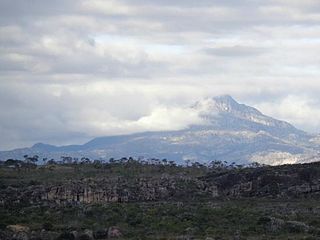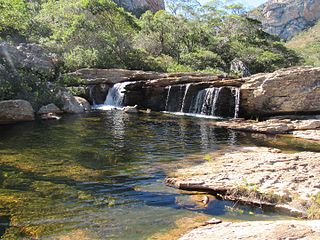Location
The Biribiri State Park is in the municipality of Diamantina, Minas Gerais, 2.5 kilometres (1.6 mi) from the municipal seat and 300 kilometres (190 mi) from the state capital of Belo Horizonte. It has an area of 16,999 hectares (42,010 acres). The park is accessed via a dirt road, but it is maintained well and can be used by cars. The entrance is 13 kilometres (8.1 mi) from the center of Diamantina.
The park is in the Serra do Espinhaço, a range with quartz rocks in the Jequitinhonha River basin. Altitudes range from 720 metres (2,360 ft) in the north to 1,480 metres (4,860 ft) in the south. The park still has traces of gold and diamond exploration. There are archaeological sites with rock inscriptions, but their locations are not marked.
Environment
The climate is tropical, with annual average temperature of about 18 °C (64 °F). The wettest month is December. Vegetation includes cerrado , gallery forest and rocky fields. There are fragments of cerradão in the north, and areas of dense forest on the slopes of streams and rivers. Flora include the Vellozia squamata, Caryocar brasiliense , jacarandá, pau-santo, Campomanesia pubescens, Hancornia speciosa and candeia, as well as many types of evergreens, orchids and bromeliads.
Fauna include maned wolf (Chrysocyon brachyurus), cougar (Puma concolor) and crested caracara (Caracara plancus). Other species include the giant anteater (Myrmecophaga tridactyla), rock cavy (Kerodon rupestris), lesser nothura (Nothura minor), helmeted manakin (Antilophia galeata) and hyacinth visorbearer (Augastes scutatus).
History
The Biribiri State Park was created by decree 39.909 of 22 September 1998. The park is named after the Fazenda Biribiri [lower-alpha 1] , which covered most of its area. It is administered by the State Institute of Forestry (IEF). The objectives are to preserve the area due to its environmental and cultural importance. The park became part of the Espinhaço Mosaic of conservation units, created in 2010.
Infrastructure is minimal. There is one caretaker who works in a shack at the park entrance, and there is a house at one of the highest points used as a lookout at periods of high fire risk. In April 2013, the Public Ministry and Justice department of Minas Gerais charged that the State Forestry Institute had been failing to comply with environmental legislation. There were serious problems such as lack of a management plan, physical structures and personnel, and land tenure issues with the ecological stations of Mata do Acauã and Mata dos Ausentes and the state parks of Biribiri, Alto Cariri, Rio Preto and Serra Negra.
Vila de Biribiri
The Estamparia SA, a textile factory, was created in the interior of what is now the park in 1876 by the Bishop of Diamantina, João Antônio dos Santos. This was one of the first and most important textile factories in the state. The workers lived in a small town in the center of a valley, which held a warehouse, school and church. The church bell was made in the factory, and the clock was donated by the Portuguese royal family. The Biribiri River, which runs through the park, powered the hydroelectric turbines that delivered electricity to the factory and the village. The factory had 1,200 workers. It closed in 1976, and the village was emptied. The village is still owned by Estamparia SA, and tourists can rent the houses. There are two restaurants in the village.

Diamantina is a Brazilian municipality in the state of Minas Gerais. Its estimated population in 2020 was 47,825 in a total area of 3,870 km2.

Serra da Canastra National Park is a national park in the Canastra Mountains of the state of Minas Gerais, Brazil.

Pedro Leopoldo is a Brazilian municipality in the state of Minas Gerais. The city is located in the Greater Belo Horizonte region. According to the most recent census of the Brazilian Institute of Geography and Statistics, the population of the city was 62,580 in 2022. The city is birthplace to prominent medium Chico Xavier and 1970 World Champion and Cruzeiro footballer Dirceu Lopes.
Acauã Ecological Station (Portuguese: Estação Ecológica Acauã is a state-operated ecological station in the State of Minas Gerais, Brazil. It is a strictly protected area and is closed to the public except for research and environmental education.
Mata dos Ausentes Ecological Station is a state-administered ecological station in Minas Gerais, Brazil.

Chapada Diamantina is a region of Bahia state, in the Northeast of Brazil. This mountain range is known as “Serra do Espinhaço,” in Minas Gerais state, south of Bahia.

The Ibitipoca State Park is a forested state park is the state of Minas Gerais, Brazil.

The Três Picos State Park is a state park in the state of Rio de Janeiro, Brazil. It preserves a large, mountainous region of Atlantic Forest.

The Nova Baden State Park is a state park in the state of Minas Gerais, Brazil. It protects a rugged, forested area that is home to several rare or endangered species of mammals.

The Sumidouro State Park is a state park in the state of Minas Gerais, Brazil. The remains of the first human inhabitants of Brazil were found in the park area in the early 19th century, along with bones of now-extinct megafauna. The main attraction is the Gruta da Lapinha, a large limestone cave.

The Cerrado State Park is a state park in the state of Paraná, Brazil. It protects a river canyon and the surrounding cerrado fields.

The Pireneus State Park, erroneously spelled "Pirineus", is a state park in the state of Goiás, Brazil. It protects an area of cerrado that includes the highest peak in the region, the 1,385 metres (4,544 ft) Pico dos Pireneus, on the watershed between the Plata and Tocantins river basins.

The Pico do Itambé State Park is a state park in the state of Minas Gerais, Brazil. It protects one of the higher peaks in the state.

The Serra do Cabral State Park is a state park in the state of Minas Gerais, Brazil.
The Baleia State Park is a state park in the state of Minas Gerais, Brazil. It protects a rugged area in the cerrado biome near the state capital of Belo Horizonte. As of 2014 nothing had been done to implement the park, which existed only on paper.

The Serra do Rola-Moça State Park is a state park in the state of Minas Gerais, Brazil. It protects a rugged area in the transition zone between cerrado and Atlantic Forest. Springs in the park are important to the water supply of the state capital, Belo Horizonte.

The Caminho dos Gerais State Park Portuguese: Parque Estadual Caminho dos Gerais is a state park in the state of Minas Gerais, Brazil. It protects a mountainous area with cerrado and caatinga vegetation that is an important source of water in a dry region.

The Serra Negra State Park Portuguese: Parque Estadual da Serra Negra is a state park in the state of Minas Gerais, Brazil. It protects a mountainous area in the Atlantic Forest biome, an important source of water in a dry region, and a potential source of tourism revenue in an area with many social problems.

The Rio Preto State Park is a state park in the state of Minas Gerais, Brazil. It protects a mountainous area of cerrado vegetation that is home to various endemic, rare or endangered species. Trails provide environmental interpretation, and lead to lookouts that give panoramic views, to rivers and waterfalls, and to archaeological sites with rock paintings.

The Serra Nova State Park Portuguese: Parque Estadual de Serra Nova is a state park in the state of Minas Gerais, Brazil. It protects an area of rugged terrain with considerable diversity of flora and fauna.
This page is based on this
Wikipedia article Text is available under the
CC BY-SA 4.0 license; additional terms may apply.
Images, videos and audio are available under their respective licenses.



















